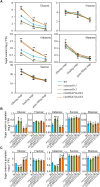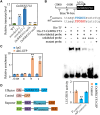Deletion of the sugar importer gene OsSWEET1b accelerates sugar starvation-promoted leaf senescence in rice
- PMID: 38423969
- PMCID: PMC11213257
- DOI: 10.1093/plphys/kiae098
Deletion of the sugar importer gene OsSWEET1b accelerates sugar starvation-promoted leaf senescence in rice
Abstract
Leaf senescence is a combined response of plant cells stimulated by internal and external signals. Sugars acting as signaling molecules or energy metabolites can influence the progression of leaf senescence. Both sugar starvation and accumulation can promote leaf senescence with diverse mechanisms that are reported in different species. Sugars Will Eventually be Exported Transporters (SWEETs) are proposed to play essential roles in sugar transport, but whether they have roles in senescence and the corresponding mechanism are unclear. Here, we functionally characterized a sugar transporter, OsSWEET1b, which transports sugar and promotes senescence in rice (Oryza sativa L.). OsSWEET1b could import glucose and galactose when heterologously expressed in Xenopus oocytes and translocate glucose and galactose from the extracellular apoplast into the intracellular cytosol in rice. Loss of function of OsSWEET1b decreased glucose and galactose accumulation in leaves. ossweet1b mutants showed accelerated leaf senescence under natural and dark-induced conditions. Exogenous application of glucose and galactose complemented the defect of OsSWEET1b deletion-promoted senescence. Moreover, the senescence-activated transcription factor OsWRKY53, acting as a transcriptional repressor, genetically functions upstream of OsSWEET1b to suppress its expression. OsWRKY53-overexpressing plants had attenuated sugar accumulation, exhibiting a similar phenotype as the ossweet1b mutants. Our findings demonstrate that OsWRKY53 downregulates OsSWEET1b to impair its influx transport activity, leading to compromised sugar accumulation in the cytosol of rice leaves where sugar starvation promotes leaf senescence.
© The Author(s) 2024. Published by Oxford University Press on behalf of American Society of Plant Biologists.
Conflict of interest statement
Conflict of interest statement. None declared.
Figures









Similar articles
-
Plasma membrane-localized hexose transporter OsSWEET1b, affects sugar metabolism and leaf senescence.Plant Cell Rep. 2024 Jan 6;43(1):29. doi: 10.1007/s00299-023-03125-3. Plant Cell Rep. 2024. PMID: 38183427
-
The PDR-type ABC transporter OsPDR1 is involved in leaf senescence by influencing melatonin biosynthesis in rice.Biochem Biophys Res Commun. 2025 Feb 16;749:151355. doi: 10.1016/j.bbrc.2025.151355. Epub 2025 Jan 17. Biochem Biophys Res Commun. 2025. PMID: 39855043
-
Comparative transcriptome analysis reveals major genes, transcription factors and biosynthetic pathways associated with leaf senescence in rice under different nitrogen application.BMC Plant Biol. 2024 May 18;24(1):419. doi: 10.1186/s12870-024-05129-x. BMC Plant Biol. 2024. PMID: 38760728 Free PMC article.
-
Genetic Dissection of Leaf Senescence in Rice.Int J Mol Sci. 2017 Dec 11;18(12):2686. doi: 10.3390/ijms18122686. Int J Mol Sci. 2017. PMID: 29232920 Free PMC article. Review.
-
Current Understanding of Leaf Senescence in Rice.Int J Mol Sci. 2021 Apr 26;22(9):4515. doi: 10.3390/ijms22094515. Int J Mol Sci. 2021. PMID: 33925978 Free PMC article. Review.
Cited by
-
Genetic Characterization of SWEET Genes in Coconut Palm.Plants (Basel). 2025 Feb 23;14(5):686. doi: 10.3390/plants14050686. Plants (Basel). 2025. PMID: 40094616 Free PMC article.
-
Characterization of the SWEET Gene Family in Blueberry (Vaccinium corymbosum L.) and the Role of VcSWEET6 Related to Sugar Accumulation in Fruit Development.Int J Mol Sci. 2025 Jan 26;26(3):1055. doi: 10.3390/ijms26031055. Int J Mol Sci. 2025. PMID: 39940826 Free PMC article.
-
Genome‑wide identification of the SWEET gene family in grape (Vitis vinifera L.) and expression analysis of VvSWEET14a in response to water stress.Physiol Mol Biol Plants. 2024 Sep;30(9):1565-1579. doi: 10.1007/s12298-024-01501-1. Epub 2024 Sep 7. Physiol Mol Biol Plants. 2024. PMID: 39310704 Free PMC article.
-
Identification of a Novel Gene MtbZIP60 as a Negative Regulator of Leaf Senescence through Transcriptome Analysis in Medicago truncatula.Int J Mol Sci. 2024 Sep 27;25(19):10410. doi: 10.3390/ijms251910410. Int J Mol Sci. 2024. PMID: 39408738 Free PMC article.
References
MeSH terms
Substances
Grants and funding
LinkOut - more resources
Full Text Sources

